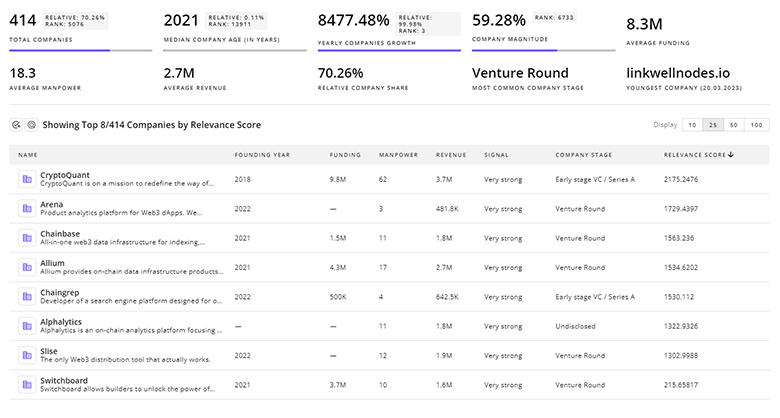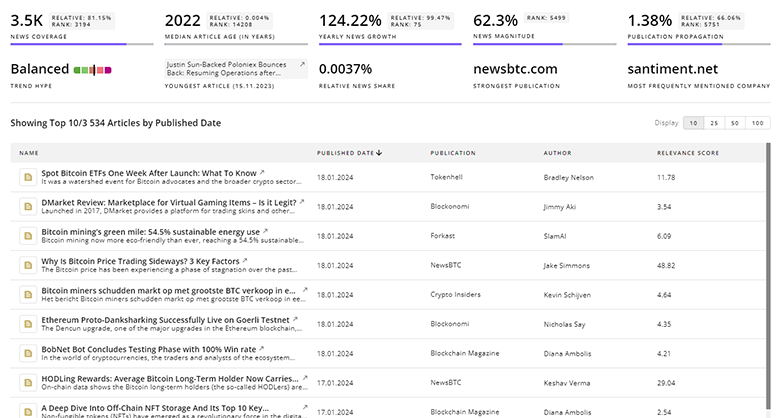
Artificial Intelligence Report
: Analysis on the Market, Trends, and TechnologiesThe AI sector is at an inflection point where scale and specialization coexist: total funding to AI companies across the internal data reaches $1,561.54 billion and topic coverage has surged by 61.16% over five years, signaling intense commercialization and attention even as patents and company-growth categories show signs of cooling. This combination means executive teams must balance near-term productization (AI as a service, AIoT) with long-term bets in cognitive and general intelligence research to capture value while managing regulatory, data, and talent risks Thematic Intelligence: Artificial Intelligence.
This report was last updated 61 days ago. Spot an error or missing detail? Help us fix it by getting in touch!
Topic Dominance Index of Artificial Intelligence
To identify the Dominance Index of Artificial Intelligence in the Trend and Technology ecosystem, we look at 3 different time series: the timeline of published articles, founded companies, and global search.
Key Activities and Applications
- Generative content and conversational agents: Rapid deployment of large language models and multimodal generative systems is driving content automation and customer-facing automation across marketing, media, and enterprise workflows.
- AI for healthcare and diagnostics: Medical imaging, drug discovery, and personalized treatment are high-value verticals where AI reduces time-to-insight and error rates, prompting targeted R&D and partnerships with clinicians.
- Business process automation and AIaaS: Cloud-delivered AI platforms and no-code tools commoditize model deployment and make AI accessible to non-specialist teams, accelerating enterprise adoption and enabling smaller firms to compete.
- Edge and AIoT integrations: Embedding intelligence into connected devices for real-time decisioning in industrial, consumer, and logistics contexts is maturing, with implications for latency, data governance, and new product forms.
- Explainability, ethics, and safety tooling: Demand for transparency and bias mitigation is spawning products and standards for explainable AI, audit trails, and trustworthy-service features aimed at regulated sectors and enterprise procurement teams.
Emergent Trends and Core Insights
- Platform consolidation pressure: Market signals point to consolidation toward integrated platforms that combine foundational models, tooling, and deployment — specialists face margin pressure unless they integrate or partner with platform providers.
- Agentic and modular AI architectures: Patents and product roadmaps emphasize modular agents and orchestrators that coordinate sub-agents for complex workflows, enabling composition of capabilities and reusability across enterprise processes.
- Divergence between media attention and patent/company growth: News coverage and topic prevalence are very strong and growing (news coverage up ~21.11% over five years) while patents and company-growth categories are classified as declining in some internal signals, implying an industry moving from exploratory R&D to commercialization and narrative-driven investment.
- AGI discourse intensifying with shorter timelines: Thought leadership and expert surveys trend toward shorter predicted horizons for powerful, general systems; this shifts investor appetite toward differentiated, long-duration bets in AGI-related ventures The road to artificial general intelligence.
- Data sovereignty and security as procurement filters: Enterprise buyers increasingly prioritize on-premise or controlled deployments and provenance features because data protection drives legal and commercial risk management.
Technologies and Methodologies
- Large language and multimodal models: LLMs plus retrieval-augmented generation are central to conversational AI and knowledge work augmentation; enterprises focus on fine-tuning, retrieval layers, and safety wrappers to reduce hallucination and liability.
- Modular agent architectures and orchestration patterns: Agent-based systems that break tasks into specialized sub-agents are emerging as a repeatable design pattern for automation of multi-step workflows.
- Explainable AI and trust scoring: Techniques that produce human-interpretable rationales and audit logs are being embedded into model lifecycles to meet regulatory and buyer demands.
- Edge inference and AIoT stacks: Optimized model compilation, lightweight inference runtimes, and federated data approaches enable low-latency AI on devices and reduce central data transfer needs.
- Hybrid neuro-symbolic and cognitive architectures: To manage brittleness in reasoning tasks, research and patents highlight combining statistical learning with symbolic reasoning to improve generalization and sample efficiency.
Artificial Intelligence Funding
A total of 40.5K Artificial Intelligence companies have received funding.
Overall, Artificial Intelligence companies have raised $1.6T.
Companies within the Artificial Intelligence domain have secured capital from 154.8K funding rounds.
The chart shows the funding trendline of Artificial Intelligence companies over the last 5 years
Artificial Intelligence Companies
- trueAGI Inc. — A company focused on human-level AGI architecture that blends neural and symbolic approaches; positions itself as AGI-as-a-service for enterprise problem solving and claims a differentiated multi-paradigm stack, making it a long-horizon strategic play with high technical risk but potentially outsized payoff.
- Ai For Alpha — A fintech specialist delivering explainable AI for investment strategies; notable for marrying rigorous academic validation with production trading systems, addressing a high-value vertical where explainability and regulatory traceability matter.
- Artificia1 — An AI delivery consultancy and integrator offering transparent pricing and pragmatic AI roadmaps; valuable to enterprises seeking fast, low-friction adoption of AIaaS and model ops capabilities.
- ARTIFICIOUS — Provider of tailored AI solutions in vision, text, and generative models for industries like finance and marketing; differentiates by combining domain-specific data pipelines with model governance features for regulated customers.
- Google DeepMind — Research leader translating foundational advances (e.g., protein folding, reasoning) into applied systems; functions as both an R&D engine and strategic partner for firms needing frontier capabilities and scientific problem-solving.
Identify and analyze 201.9K innovators and key players in Artificial Intelligence more easily with this feature.

201.9K Artificial Intelligence Companies
Discover Artificial Intelligence Companies, their Funding, Manpower, Revenues, Stages, and much more
Artificial Intelligence Investors
TrendFeedr’s investors tool offers a detailed view of investment activities that align with specific trends and technologies. This tool features comprehensive data on 76.4K Artificial Intelligence investors, funding rounds, and investment trends, providing an overview of market dynamics.

76.4K Artificial Intelligence Investors
Discover Artificial Intelligence Investors, Funding Rounds, Invested Amounts, and Funding Growth
Artificial Intelligence News
Stay informed and ahead of the curve with TrendFeedr’s News feature, which provides access to 517.2K Artificial Intelligence articles. The tool is tailored for professionals seeking to understand the historical trajectory and current momentum of changing market trends.

517.2K Artificial Intelligence News Articles
Discover Latest Artificial Intelligence Articles, News Magnitude, Publication Propagation, Yearly Growth, and Strongest Publications
Executive Summary
AI investment and attention are exceptionally high, but the landscape is bifurcating: commoditized model access and AIaaS enable rapid adoption, while strategic differentiation now depends on vertical expertise, governance features, and ability to integrate modular agent architectures into business workflows. Boards should prioritize three actions: (1) capture short-term value by adopting managed AI services with contractual data controls; (2) invest selectively in core capabilities that create defensible enterprise value (vertical datasets, explainability, edge deployment); and (3) allocate a small portfolio of long-term bets into cognitive and AGI-related research where potential returns are asymmetric. This balanced approach aligns near-term revenue capture with resilience to platform consolidation and emerging regulatory constraints.
Interested in enhancing our coverage of trends and tech? We value insights from experts like you - reach out!







